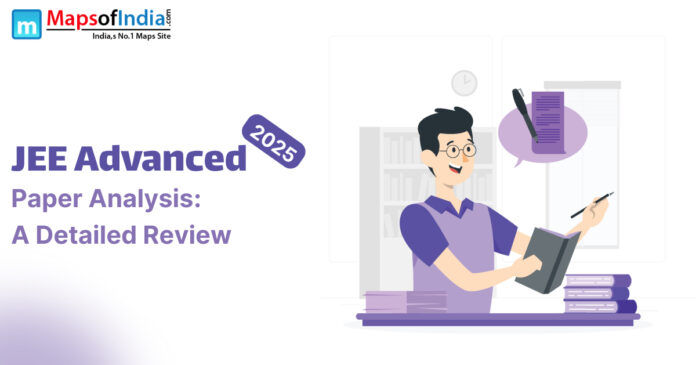JEE Advanced 2025, which was conducted by IIT Kanpur on May 18, 2025, is concluded, and students and teachers have ample data to consider. This blog post covers a detailed analysis of the exam, focusing on its pattern, section-wise analysis, student reaction as well as year-on-year comparisons.
Examination Structure
JEE Advanced 2025 had two papers:
Paper 1: 9:00 AM to 12:00 PM
Paper 2: 2:30 PM to 5:30 PM
Every paper had 48 questions on the three parts, that is Physics, Chemistry and Mathematics. The format of the examination was computer-based, which includes a blend of single-choice, multiple-choice, and numerical answer type questions.
General Student Feedback
The general opinion of the candidates is that the paper was of moderate difficulty. Level: Easy(1-1.5) Paper 1 seemed easy in comparison to the previous questions and not even a single question was twisted. Paper 2, on the other hand, was perceived as relatively more difficult with Mathematics and Physics sections being tougher. According to the students, the paper was not difficult but conceptual and a time management was the key to crack it.
Subject-Wise Analysis
Physics
Paper 1: The Physics part in Paper 1 was moderate tough. Questions were being asked conceptually as well as based on formulae from the sections of Thermodynamics, Electromagnetic Induction, Optics, Modern Physics, Fluid Mechanics, Sound Waves and Heat Transfer. Most of the questions came from Electromagnetic Induction, Modern Physics, there were only a hand full from other topics. The questions were meant to assess theoretical knowledge as well as application.
Paper 2: Paper 2 Physics was held to be tougher for students. There were always a few topics such as Electrostatics, Sound Waves, Optics, Mechanics, and Thermodynamics that were highlighted.
Students found the questions to be more time-consuming and required extensive calculations, which added to the difficulty level. The increased complexity in Paper 2 highlighted the need for thorough preparation and a strong grasp of fundamental concepts.
Chemistry
Paper 1: The chemistry section on Paper 1 was very fair in terms of coverage for Organic, Inorganic and Physical Chemistry. ORGANIC CHEMISTRY: Emphasis was laid on NAMED REACTIONS and MECHANISM, whereas INORGANIC CHEMISTRY was based on the NCERT, particularly COORDINATION COMPOUNDS and TRANSITION ELEMENTS. In Physical Chemistry, too, the areas tested were Chemical Kinetics, Thermodynamics, and Electrochemistry, taking question on both concepts of the sub-sections as well as numerical ability.
Paper 2: The Chemistry section in Paper 2 was of a moderate level and carried equal weightage from all three sections. Question Trend: Most Organic Chemistry questions were from aldehydes and ketones, polymers, biomolecules, and a mixed-concept question. Inorganic Chemistry featured questions from p-block elements, chemical bonding and coordination compounds. Physical Chemistry deals with electrochemistry, ionic and chemical equilibrium, and some portion of surface chemistry. Overall, students found this section to be tricky, requiring careful analysis and application of concepts.
Mathematics
Paper 1: The mathematics section was moderately difficult. Subjects were Calculus (Differentiation, Integration), Algebra (Matrices, Complex Numbers), Coordinate Geometry (3D Geometry, Conic Sections) and Probability. The questions were wordy and required multi-step solutions that tested students’ analytical and time management skills. Numerous candidates mentioned that the Mathematics exam was tough as the questions were application-based and tested the candidates quite deeply.
Paper 2: The mathematics section of paper 2 was the most difficult compared to all of the subjects. Some other things that I have covered are Functions, Limits, Derivatives, Application of derivatives, Definite integration, Area Under the Curve, Inverse trigonometric functions, Vectors, 3D Geometry, Circles, Parabolas, Quadratic equations, Permutations and Combinations, and Probability. Questions were lengthy, had twisted calculations and required to be solved with good accuracy and speed. This part was the most difficult, and students needed to spend a good amount of time preparing, as well as have the ability to solve problems..
Comparison with Previous Years
JEE Advanced 2025 was a fair and even exam that tested students on their understanding of concepts, problem-solving skills, and time management. A large no. of students felt that Paper 1 was easier, while Paper 2 had tougher and more time-consuming questions, especially in Maths and Physics. Candidates who had a strong grasp of fundamental concepts and effective problem-solving strategies were better prepared to tackle the examination. As the results are awaited, the insights from this year’s paper analysis will serve as valuable feedback for future aspirants and the organising bodies to refine the examination process.
Conclusion
JEE Advanced 2025 was a well-balanced paper that checked conceptual clarity, the problem-solving method as well as the time management capabilities of the candidates. While Paper 1 was easier, paper 2 had more time consuming and difficult questions, especially in Maths and Physics. Examinees with good understanding of basic principles and with a good problem solving approach fared better. As the results are awaited, the insights from this year’s paper analysis will serve as valuable feedback for future aspirants and the organizing bodies to refine the examination process.




